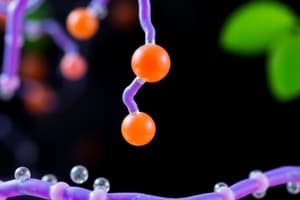Podcast
Questions and Answers
What is the primary structural feature of cellulose that contributes to its strength?
What is the primary structural feature of cellulose that contributes to its strength?
- Presence of glycoproteins
- Beta configuration with linear chains (correct)
- Hydroxyl groups on glucose units
- Alpha configuration with branching points
Which of the following carbohydrates serves as a primary energy source in the body?
Which of the following carbohydrates serves as a primary energy source in the body?
- Glycogen (correct)
- Starch
- Cellulose
- Chitin
What role do carbohydrates play in cell recognition and signaling?
What role do carbohydrates play in cell recognition and signaling?
- Form glycoproteins and glycolipids (correct)
- Act as ATP for energy production
- Serve as a source of dietary fiber
- Provide structural support in cell walls
Which of the following is a monosaccharide?
Which of the following is a monosaccharide?
What characteristic of glycogen enhances its accessibility for energy release?
What characteristic of glycogen enhances its accessibility for energy release?
What type of carbohydrate is sucrose?
What type of carbohydrate is sucrose?
What bond type primarily links glucose units in starch?
What bond type primarily links glucose units in starch?
Which carbohydrate is primarily involved in providing structural support in arthropods?
Which carbohydrate is primarily involved in providing structural support in arthropods?
Which of the following carbohydrates is primarily used for energy storage in animals?
Which of the following carbohydrates is primarily used for energy storage in animals?
What did Joseph Louis Proust contribute to the understanding of carbohydrates?
What did Joseph Louis Proust contribute to the understanding of carbohydrates?
What is the primary function of carbohydrates in living organisms?
What is the primary function of carbohydrates in living organisms?
What distinguishes amylose from amylopectin?
What distinguishes amylose from amylopectin?
How do carbohydrates contribute to dietary fiber?
How do carbohydrates contribute to dietary fiber?
What ratio of elements is commonly found in carbohydrates based on their empirical formula?
What ratio of elements is commonly found in carbohydrates based on their empirical formula?
Which feature distinguishes chitin from cellulose?
Which feature distinguishes chitin from cellulose?
Which structural polysaccharide is a major component of dietary fiber?
Which structural polysaccharide is a major component of dietary fiber?
What is the function of carbohydrates when broken down into glucose?
What is the function of carbohydrates when broken down into glucose?
Which of the following best describes the term 'saccharine'?
Which of the following best describes the term 'saccharine'?
What is the primary role of fiber, a complex carbohydrate, in the human diet?
What is the primary role of fiber, a complex carbohydrate, in the human diet?
How did Robert Boyle contribute to the early understanding of carbohydrates?
How did Robert Boyle contribute to the early understanding of carbohydrates?
Which chemist is known for relating the empirical formula of carbohydrates to their composition?
Which chemist is known for relating the empirical formula of carbohydrates to their composition?
Which carbohydrate is commonly known as blood sugar?
Which carbohydrate is commonly known as blood sugar?
What class of biomolecules do carbohydrates belong to?
What class of biomolecules do carbohydrates belong to?
What was the observable characteristic of carbohydrates recognized in ancient times?
What was the observable characteristic of carbohydrates recognized in ancient times?
What is one potential negative consequence of consuming too many simple carbohydrates?
What is one potential negative consequence of consuming too many simple carbohydrates?
Which of the following carbohydrates is digested more slowly, leading to a sustained release of energy?
Which of the following carbohydrates is digested more slowly, leading to a sustained release of energy?
Which health risk is associated with diets low in fiber and high in refined sugars?
Which health risk is associated with diets low in fiber and high in refined sugars?
What type of carbohydrate provides a rapid source of energy and includes sugars such as glucose?
What type of carbohydrate provides a rapid source of energy and includes sugars such as glucose?
Which type of carbohydrate is primarily utilized for energy storage in animals?
Which type of carbohydrate is primarily utilized for energy storage in animals?
Which function is NOT typically associated with dietary carbohydrates?
Which function is NOT typically associated with dietary carbohydrates?
In which foods would you primarily find starch?
In which foods would you primarily find starch?
Which of the following is NOT a category of carbohydrates?
Which of the following is NOT a category of carbohydrates?
Study Notes
Course Overview
- Course Title: BCH 302 - Chemistry and Metabolism of Carbohydrates
- Lecturers: Dr. Palmah Nyadar, Dr. Jamila Omale, Mrs. Funmi Audu, Mr. Yunusa Imam
- Session: 2023/2024, 2 Units, 30 Lecture Hours
- Focus Areas: Chemistry and function of polysaccharides, isolation and purification, Calvin pathway, disorders of carbohydrate metabolism.
Historical Perspective on Carbohydrates
- Early recognition of sweet substances like fruits and honey, primarily glucose and fructose.
- Late 1600s: Robert Boyle observed burning plant materials produced water and carbon dioxide; molecular structures were not yet understood.
- Early 1800s: Joseph Louis Proust introduced the term "carbohydrates," identifying them as compounds mainly composed of carbon, hydrogen, and oxygen (C, H, O).
- 1820s: Jean-Baptiste Dumas and Justus von Liebig formalized the understanding of carbohydrates through studying various sugars and starches.
Types of Carbohydrates
-
Monosaccharides: Single sugar molecules acting as building blocks.
- Examples:
- Glucose: Primary energy source (blood sugar).
- Fructose: Found in fruits and honey, very sweet.
- Galactose: Present in dairy, links to glucose to form lactose.
- Examples:
-
Disaccharides: Composed of two monosaccharide molecules linked by glycosidic bonds.
- Examples:
- Sucrose: Table sugar made of glucose and fructose.
- Lactose: Sugar in milk made of glucose and galactose.
- Maltose: Found in germinating seeds, composed of two glucose molecules.
- Examples:
-
Polysaccharides: Complex carbohydrates with many monosaccharide units.
- Examples:
- Starch: Storage form in plants composed of glucose.
- Glycogen: Storage form in animals, primarily in liver and muscles.
- Cellulose: Structural component of plant cell walls.
- Chitin: Found in arthropods' exoskeletons and fungi cell walls.
- Examples:
Structural Details
-
Starch: Linked primarily by α(1→4) glycosidic bonds, with α(1→6) bonds for branching. Exists as:
- Amylose: Mostly linear structure.
- Amylopectin: Branched structure.
-
Glycogen: Highly branched, removable glucose units stored for energy.
-
Cellulose: Linear polymer linked by β(1→4) glycosidic bonds, providing rigidity and structural support.
-
Chitin: Similar structure to cellulose but composed of N-acetylglucosamine.
Functions of Carbohydrates
- Energy Source: Broken down into glucose for ATP production via cellular respiration.
- Energy Storage: Stored as glycogen in animals and starch in plants for use when energy is needed.
- Structural Role: Structural support in plants (cellulose) and arthropods (chitin).
- Cell Recognition and Signaling: Carbohydrates on cell surfaces in glycoproteins and glycolipids assist in cellular communication.
- Dietary Fiber: Non-digestible carbohydrates that promote digestive health and may reduce certain disease risks.
Dietary Carbohydrates
- Two categories:
- Simple Carbohydrates: Quickly digested, include monosaccharides and disaccharides; excessive consumption leads to health issues such as obesity and diabetes.
- Complex Carbohydrates: Longer digestion time, provide sustained energy release; beneficial for health through whole foods like grains, fruits, and vegetables.
Health Implications
- Diets high in refined sugars and low in fiber increase chronic disease risks, while those rich in complex carbohydrates and fiber promote better health outcomes.
Assignments and Topics for Discussion
- Definitions and structures of polysaccharides.
- Roles of polysaccharides in living organisms and various industries (food, pharmaceuticals, biomedical).
- Comparison of energy utilization between glycogen and cellulose.
Studying That Suits You
Use AI to generate personalized quizzes and flashcards to suit your learning preferences.
Related Documents
Description
This quiz covers the chemistry and metabolism of carbohydrates, focusing on polysaccharides, their isolation and purification, and the Calvin pathway. Additionally, it addresses disorders related to carbohydrate metabolism. Prepare to deepen your understanding of biochemistry in this essential field!




